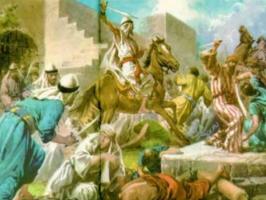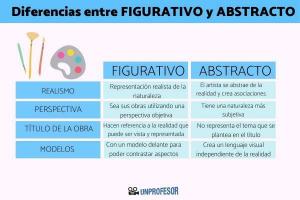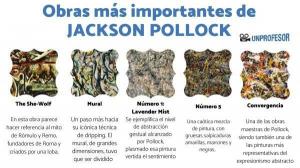4 phases of the Spanish Civil War
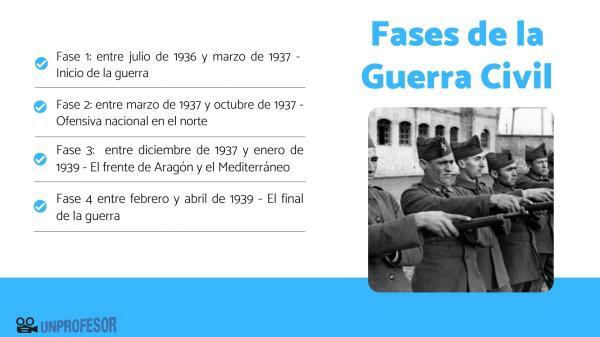
Of all the wars that have taken place in Spain, possibly the most relevant has been the Spanish Civil War. It took place between 1936 and 1939 and was a turning point for a Spain that would never be the same as before. To understand this war in depth by seeing its different stages, in this lesson of a Teacher we must talk about the phases of the Spanish Civil War.
The first phase of the Civil War begins in July 1936, when a coup d'état organized by Spanish soldiers from the extreme right-wing factions of Spain began, among which were Franco, Mola and Sanjurjo.
The beginning of this coup took place in Morocco, the place where the first phase of the war begins, since the first objective was go from there to the capital of Madrid to conquer her. In a few days, uprisings were occurring throughout Spain, starting the war between the rebels and the Republicans to govern Spain.
The first phase of the Civil War took place between July 1936 and March 1937, being marked by the intention of the rebels to take Madrid. This started when
Frank and his troops crossed from Morocco to Seville, joining other armies in the area and forming columns to take nearby cities, with Huelva, Malaga and Granada being the first to fall.After these quick victories, Franco assumed command of the southern army, he having taken practically all the relevant cities of the southern part of Spain. Getting more troops from Morocco, Franco began to send columns of armies towards the center of the Peninsula, taking Cáceres. But for unknown reasons, General Franco did not want to quickly attack Madrid, which would surely have ended the war, but rather he preferred to liberate Toledo first Republican hands, prolonging the war and causing thousands more deaths.
During this phase, General Sanjurjo (who should lead the rebels) he died, for which the National Defense Board was formed in which Frank Generalissimo and leader of the rebels, largely due to the fame he gained by liberating Toledo from Republican hands.
After being appointed Generalissimo, Franco tried to take Madrid in the so-called Battle of Madrid between November and December 1936, but the loss of time had made the republicans able to strengthen their defenses and they managed to stop the attack. In this point, Republican leaders fled to Valencia and the rebels prepared to attack other places.
The second of the Phases of the Spanish Civil War is the so-called national offensive in the north, encompassing between March 1937 and October 1937. This phase of the war was marked by the movement of the rebel troops to the north, due to the impossibility of taking the Spanish capital of Madrid.
In the north, the main general was Mola, who had taken important cities such as Navarra, Álava and Guipúzcoa to, a little later, also conquer San Sebastián. In this situation, the only major city in the area that left unconquered was Bilbao and, to take it, Franco ordered to launch bombardments from the condor legion throughout the area, killing hundreds to take the city. Therefore, in just two months the city of Bilbao fell into the hands of the rebels.
On June 4 General Mola died in a plane crash, changing command of the area to General Dávila. The armies of the new general were joined by Italian soldiers, managing to conquer Asturias and Cantabria in a short time and occupying the entire northern front by the rebel troops.
The third phase of the Spanish Civil War takes place between December 1937 and January 1939, being the part of the war in which the rebels attacked Aragon in an attempt to reach Valencia, where the Republican leaders were.
This phase is based on 2 great battles, the Battle of Teruel and the Battle of the Ebro, being two of the most important of the entire war:
- The Battle of Teruel It took place between December 1937 and February 1938, and in it the rebels managed to take the city, although the Republicans would not take long to recover it. Taking advantage of the space achieved by the battle, the rebels began the Aragon campaign, taking cities such as Vinaròs.
- The second major battle of this period was the Battle of the Ebro, which occurred between July 1938 and November 1938, in which both armies collided near the Ebro in the Tarragona area. Considered as the battle most cruel and bloodthirsty of the entire war, ended with the victory of the rebels, forcing the republican leaders to flee from Spain and being the victory that would lead them to win the war.
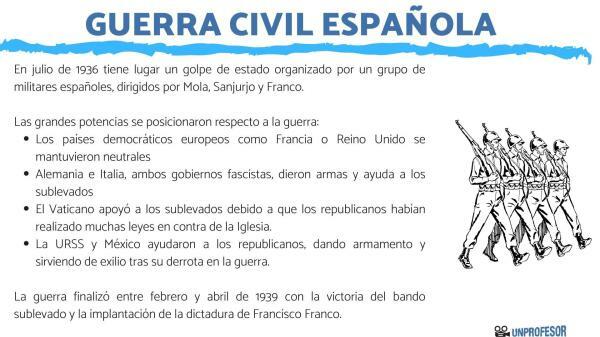
To conclude this lesson on the phases of the Spanish Civil War, we must talk about the last of these phases, being the one known as the end of the war, and which took place between February and April 1939.
After the flight of all the republican leaders to France and other regions, the rebels were able to take Madrid on May 28, 1939. After this, many cities were surrendering to see that the war had ended with the victory of the rebels.
On April 1, 1939, Franco declared the war over. becoming dictator of Spain and holding this position until his death in 1975. This ended the civil war, one of the worst moments in the history of Spain, with four phases that had been dominated by the rebel side.

